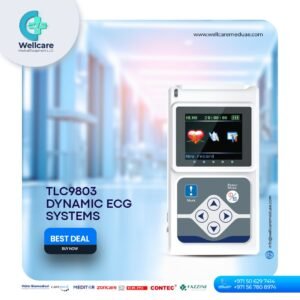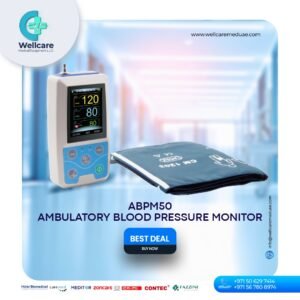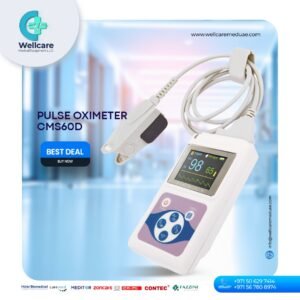Ultrasound Machine supplier in UAE
In the UAE, ultrasound machines are indispensable to the healthcare landscape, offering a range of benefits that significantly enhance diagnostic and therapeutic practices. These devices are pivotal for providing accurate and detailed imaging of internal structures using high-frequency sound waves, which is especially valuable in a country known for its commitment to advanced medical technology. The non-invasive nature of ultrasound makes it a preferred tool for various diagnostic applications, including obstetrics, cardiology, and emergency medicine, allowing healthcare providers to evaluate internal organs and conditions without exposing patients to ionizing radiation. This is particularly important in sensitive areas such as prenatal care, where the ability to monitor fetal development safely and effectively is crucial. Furthermore, ultrasound machines facilitate real-time imaging, which is essential for guiding medical procedures with precision. This capability allows for accurate needle placement during biopsies or injections, minimizing risks and improving patient outcomes. The technology's ability to provide immediate feedback also supports early detection of conditions, from tumors and cysts to internal injuries, enabling timely intervention and better management of health conditions. In a country with a diverse population and high standards of healthcare, the versatility and safety of ultrasound make it a valuable asset across multiple medical specialties, including orthopedics, urology, and emergency care. Moreover, ultrasound contributes to a more comfortable patient experience. Its painless and quick procedure, combined with real-time visualization of internal structures, can alleviate patient anxiety and provide reassurance. The widespread availability and cost-effectiveness of ultrasound machines further enhance their importance in the UAE, making high-quality diagnostic services accessible to a broad segment of the population. In summary, ultrasound machines play a crucial role in the UAE’s healthcare system by offering precise diagnostics, safe imaging, and improved patient care, reflecting the country’s dedication to integrating advanced technologies in medical practice.
In the present world, ultrasound machines have become highly relevant due to their versatility, non-invasive nature, and critical role in modern medical diagnostics and treatment. Their significance is underscored by several key factors:
1. Enhanced Diagnostic Capabilities
Ultrasound machines are vital tools in contemporary medicine, offering detailed imaging of internal organs and tissues. Their ability to provide real-time images helps in the accurate diagnosis of a wide range of conditions, from abdominal issues to cardiac anomalies. This capability is essential for detecting diseases at an early stage, which can significantly improve treatment outcomes and patient survival rates. For example, in obstetrics, ultrasound allows for detailed monitoring of fetal development and the detection of potential issues early in pregnancy, which is crucial for ensuring maternal and fetal health.
2. Non-Invasive and Safe Imaging
One of the most important aspects of ultrasound technology is its non-invasive nature. Unlike other imaging modalities such as X-rays or CT scans, ultrasound uses high-frequency sound waves rather than ionizing radiation. This makes it a safer option for repeated use and particularly important for vulnerable populations such as pregnant women and children. The safety profile of ultrasound is a significant factor in its widespread adoption in various diagnostic and monitoring scenarios.
3. Versatility and Multifunctionality
Ultrasound machines are incredibly versatile and can be used across a wide range of medical specialties. They are employed in obstetrics, cardiology, emergency medicine, and orthopedics, among others. The multifunctionality of ultrasound allows it to address various diagnostic needs with a single device, making it a cost-effective and efficient choice for healthcare providers. For instance, ultrasound is used to guide biopsies and injections, assess musculoskeletal injuries, and monitor the progression of chronic conditions.
4. Real-Time Imaging and Procedure Guidance
The ability to produce real-time images is a significant advantage of ultrasound technology. This feature is crucial for guiding medical procedures, such as needle insertions and catheter placements, with precision. The immediate feedback provided by ultrasound imaging helps in performing accurate interventions, reducing the risk of complications and improving patient safety. This real-time capability is particularly valuable in emergency settings, where rapid assessment and intervention are critical.
5. Accessibility and Advancements in Technology
Ultrasound technology has become more accessible due to advancements in technology and reduced costs. Portable and handheld ultrasound devices are now available, making it possible to perform imaging in diverse settings, including remote or underserved areas. These advancements have broadened the reach of ultrasound technology, enabling more widespread use and integration into routine medical practice.
6. Improved Patient Experience
Ultrasound procedures are generally quick, painless, and do not require special preparation, contributing to a positive patient experience. The ability to provide visual feedback during the procedure can also be reassuring for patients, particularly in prenatal care where seeing the fetus in real-time can be a profoundly comforting experience. This patient-centered approach enhances the overall quality of care and helps in building trust between healthcare providers and patients.
7. Contribution to Preventive Medicine
Ultrasound is a valuable tool in preventive medicine, allowing for the early detection of potential health issues before they develop into more serious conditions. Routine screenings and monitoring using ultrasound can identify risk factors or emerging health problems, enabling proactive management and prevention strategies. For example, ultrasound is used in routine screenings for certain cancers and cardiovascular conditions, helping to catch issues early and reduce the likelihood of severe outcomes.
ultrasound machines are highly relevant in the present world due to their enhanced diagnostic capabilities, non-invasive nature, versatility, and real-time imaging advantages. They play a crucial role in modern medicine by providing safe, effective, and accessible imaging solutions that improve patient care, support accurate diagnostics, and guide medical procedures with precision. As technology continues to advance, the relevance and utility of ultrasound machines in healthcare are likely to grow even further, making them an indispensable tool in contemporary medical practice.
Well Care Medical Equipment LLC provides a diverse range of ultrasound machines tailored to various diagnostic and therapeutic needs. the different types of ultrasound machines offered by Well Care Medical Equipment LLC:
1. Portable Ultrasound Machines
Portable ultrasound machines are compact and lightweight, designed for mobility and flexibility. These devices are ideal for use in various settings, including:
- Emergency Rooms: Quickly assessing patients in urgent situations.
- Bedside Diagnostics: Conducting assessments at the patient’s bedside in hospitals or clinics.
- Field Use: Useful for mobile clinics or remote locations where traditional ultrasound machines might be impractical.
Portable ultrasound machines provide real-time imaging and are equipped with essential features for quick and effective diagnostics.
2. Diagnostic Ultrasound Machines
Diagnostic ultrasound machines are designed for detailed imaging and are commonly used in hospitals and specialized clinics. They include:
- Abdominal Ultrasound: For imaging abdominal organs such as the liver, kidneys, and pancreas.
- Cardiac Ultrasound: Also known as echocardiography, it evaluates heart function and structure.
- Obstetric Ultrasound: For monitoring fetal development during pregnancy.
These machines offer high-resolution imaging and various advanced features to support accurate diagnosis and comprehensive evaluations.
3. 3D/4D Ultrasound Machines
3D and 4D ultrasound machines provide three-dimensional and real-time imaging, offering enhanced visualization of anatomical structures. These machines are used for:
- Obstetric Imaging: Providing detailed views of the fetus, which can be particularly useful for assessing fetal development and detecting abnormalities.
- Orthopedic Imaging: Offering detailed views of musculoskeletal structures to aid in the diagnosis of joint and soft tissue conditions.
3D/4D ultrasounds provide more detailed images compared to traditional 2D ultrasounds, improving diagnostic capabilities and patient experience.
4. Doppler Ultrasound Machines
Doppler ultrasound machines measure the movement of blood and fluids within the body, utilizing Doppler technology to assess:
- Blood Flow: Evaluating the speed and direction of blood flow in vessels.
- Cardiac Function: Assessing heart valve function and blood flow within the heart.
These machines are crucial for diagnosing vascular conditions, heart diseases, and monitoring blood flow in various clinical settings.
5. High-Resolution Ultrasound Machines
High-resolution ultrasound machines are designed for detailed imaging of small structures and tissues. They are often used in:
- Breast Imaging: Detecting and evaluating abnormalities in breast tissue.
- Thyroid Imaging: Assessing thyroid gland conditions and detecting nodules.
These machines offer superior image clarity, making them suitable for detailed examinations and precise diagnostics.
6. Clinical Ultrasound Systems
Clinical ultrasound systems are advanced, multi-functional devices used in specialized medical settings. They include:
- General Imaging Systems: Suitable for a wide range of diagnostic applications, including abdominal, pelvic, and musculoskeletal imaging.
- Specialized Systems: Tailored for specific medical fields, such as vascular or musculoskeletal imaging.
These systems are equipped with advanced features, including enhanced imaging technologies and extensive software options, to support complex diagnostic and therapeutic needs.
7. Handheld Ultrasound Devices
Handheld ultrasound devices are compact and user-friendly, offering portability and ease of use. They are typically used for:
- Point-of-Care Diagnostics: Quick assessments in clinics or at the patient’s side.
- Primary Care: Enabling general practitioners to perform basic ultrasound examinations.
These devices offer a balance between portability and functionality, making them suitable for a variety of clinical applications.
In summary, Well Care Medical Equipment LLC provides a comprehensive range of ultrasound machines to meet diverse diagnostic and therapeutic needs.
How do I choose the right ultrasound machine for my medical practice?
Choosing the right ultrasound machine depends on factors such as the type of examinations you perform, portability requirements, image quality, and budget. Wellcare Medical Equipment LLC’s team of experts in the UAE can guide healthcare providers in selecting the most suitable ultrasound system, whether it’s for obstetrics, cardiology, musculoskeletal imaging, or general diagnostics, ensuring reliable performance and patient safety.




